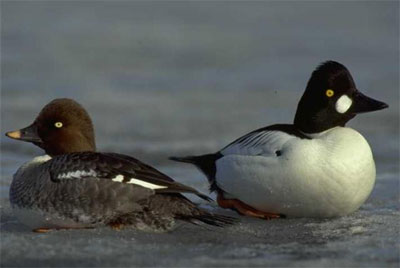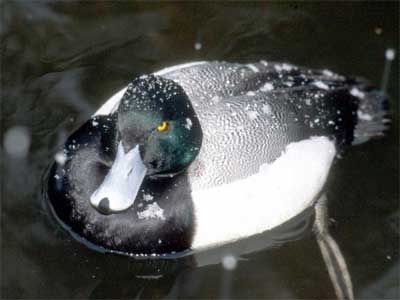I'd like to introduce Matt Medler, the Science Coordinator for the Boreal Songbird Initiative. Starting this week, he will be contributing to the BSI Boreal Bird Blog on a regular basis. Prior to joining BSI, Matt worked at the New York State Department of Environmental Conservation, and he also worked for several years at the Cornell Laboratory of Ornithology. An avid sound recordist, he has participated in ornithological field research and/or sound recording trips in several countries, including Sweden, Costa Rica, Brazil, Mexico, New Zealand, and Canada. Matt is a nearly lifelong resident of New York State, and enjoys birding the varied regions of the Empire State, especially the Adirondacks and Lake Champlain Valley.
- Jeff Wells
Boreal Ducks on Lake Champlain
Quick—which of the following species in North America has the highest percentage of its breeding population found in the Boreal Forest region: Common Merganser, Red-breasted Nuthatch, or Pine Siskin?
If this question had been posed to me a year ago, before I began working at BSI, I would have grappled with a choice between the nuthatch and the siskin, two conifer-loving species. Common Merganser would barely have entered into the equation, because, as I would have thought, "There aren't many waterfowl species breeding in the Boreal, especially in large numbers." However, regardless of whether I had ultimately decided on Pine Siskin or Red-breasted Nuthatch as the "most Boreal" bird, my answer to the question would have been wrong.
As it turns out, there are many waterfowl species that breed in the Boreal Forest region, and Common Merganser is one of them. In fact, more than half of the North American population of Common Merganser breeds in the Boreal (53% to be exact), a number that substantially surpasses the percentage of the Pine Siskin (37%) and Red-breasted Nuthatch (25%) populations found there. (These latter two species do not extend as far north in the Boreal as the merganser, and also have extensive populations in the montane coniferous forests of the western United States.)
The Boreal's importance to waterfowl was highlighted for me during a recent birding outing along Lake Champlain, a 120-mile-long lake the straddles the New York-Vermont border and extends slightly into southern Québec. Lake Champlain is a deep lake in many places, with the maximum depth exceeding 400 feet, so the main portion of the lake remains open except during exceedingly cold winters. During my visit just before New Year's, the lake's ice edge was conveniently located at an excellent birding spot in Port Henry, New York. As is often the case, there was a good assortment of bird activity right at the ice edge—several hundred gulls sitting on the ice itself, separated by a respectful distance from two adult Bald Eagles. Just offshore, I immediately spotted a decent flock of Common Goldeneye, and began counting them and searching for an uncommon Barrow's Goldeneye amongst them. My goldeneye tally came to just over 300 birds, which is an impressive total in many places, but a fairly modest number on Lake Champlain, where winter flocks can often exceed 1,000 individuals.

Common Goldeneye
Copyright Ducks Unlimited
In fact, as I broadened my scan of the lake to include Vermont waters, I quickly came across a much larger mixed flock of goldeneye and scaup. This flock stretched for hundreds of yards, beginning with scattered individuals on the end, and then becoming more dense at the core, where both scaup and goldeneye were packed tightly together. Due to the distance and thousands of diving ducks involved, it was difficult for me to come up with a reliable estimate of the numbers of birds, but this was easily the largest flock of waterfowl I've ever seen on Lake Champlain, with at least 5,000 individuals present. And, probably the vast majority of these ducks came from Boreal breeding grounds to the north. Common Goldeneye is one of the duck species most reliant on the Boreal Forest, with more than 80% of the continental population breeding there. Both scaup species, meanwhile, are also dependent on Boreal wetlands for breeding—two-thirds of all Lesser Scaup breed in the Boreal, while more than half of North America's Greater Scaup nest there.

Greater Scaup
Copyright Ducks Unlimited
But, the Boreal waterfowl bonanza wasn't quite finished! As I watched this huge flock in awe, I noticed several long lines of sleek Common Mergansers fly swiftly through my field of view. Eventually, I turned to find approximately 1,000 mergansers stretched along the ice edge (including a few individuals that passed within a few feet of the Bald Eagles). Common Mergansers breed along the shores of Lake Champlain, so they can be seen in the area year-round, but to see such a large gathering was quite noteworthy. And, to make the spectacle even more impressive, at least 90% of the mergansers were stunning males, with their dark heads contrasting with white underparts that in some cases were lightly tinged pink.
Located at the Canadian border, not far from the southern edge of the Boreal Forest, Lake Champlain is well situated to host large numbers of boreal waterfowl. But, you don't have to go birdwatching in northern New York to witness the Boreal's incredible importance to waterfowl. Overall, the Boreal Forest supports 38% of North America's breeding waterfowl populations, making it the continent's second "duck factory" after the prairie pothole region. During the winter, huge scoter flocks along the Atlantic and Pacific coasts, American Black Ducks in the eastern U.S., Trumpeter Swans in the Pacific Northwest, and numerous other waterfowl congregations all likely have their origin in the Boreal Forest. Visit the BSI Bird Guide waterfowl section to learn if wintering waterfowl in your area might have a boreal connection.
- Matt Medler

